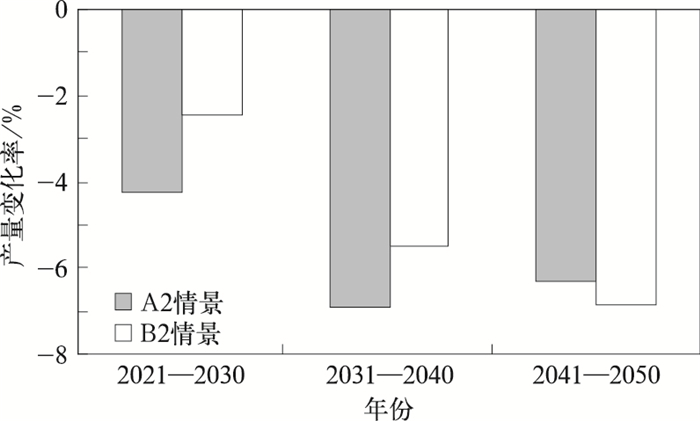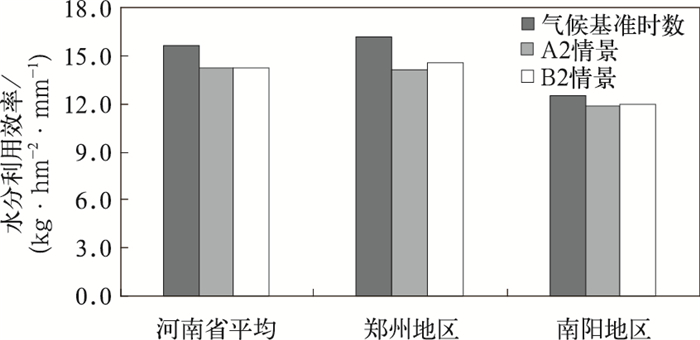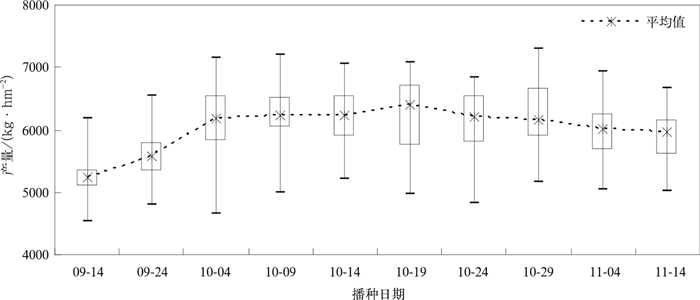Possible Impacts of Future Climate Change on Irrigated Winter Wheat and Adaptive Strategies in Henan Province
-
摘要: 灌溉是河南省冬小麦最重要的种植管理模式。在DSSAT-CERES小麦模型参数调试和区域适用性验证的基础上,利用区域气候模式PRECIS输出的未来气候情景资料,量化分析了2021—2050年河南省灌溉条件下冬小麦产量的可能变化,结果表明:若不采取其他措施,未来A2,B2两种温室气体排放情景下,河南省冬小麦产量平均减少5%左右,A2情景减产率略高于B2;随着产量降低,产量波动区间略有缩小,但25%~75%的稳产区间也相应缩小,且B2情景下更容易出现极端低产的年份;冬小麦水分利用效率相应降低。采取适当应对措施,如延迟播种期、减小种植密度等有利于提高产量或缓解减产趋势。Abstract: Henan Province is one of the most important growing areas for winter wheat in China, and irrigation is the main planting and managing mode for winter wheat. Traditionally, winter wheat is watered three times during the whole growing season, namely, irrigating before overwintering, at green turning stage and jointing to grain filling stage respectively. As to the impact of climate warming, how the irrigated wheat would be influenced in the future has been concerned.DSSAT-CERES Wheat Model is widely used in China and has been proved feasible in future influence simulating. Based on parameters debugging and regional validation of the DSSAT-CERES Wheat Model, two different climatic scenarios data which is outputted by regional climate model PRECIS is combined to study the possible yield variation of winter wheat in the future 30 years of 2021—2050 in Henan Province. The reduction rate of yield and the reduction distribution as well as the changing of water use efficient (WUE) are shown.By drawing quartile graph, the fluctuation of the yield in the future is analyzed.In case of two kinds of greenhouse gas emission scenarios A2 and B2, on the assumption that the traditional irrigation mode doesn't change, the average rate of yield reduction is 5% approximately, and the reduction in A2 scenario is more obvious than B2. Generally speaking, the final yield reduction on the east and southwest plain is relatively less, and the largest reduction rate appears in different decade for different scenarios. With the yield reduction, the variability of yield decreases a little, but 25%—75% interval which means stable yield also shrinks.Extreme low yield is more likely to occur in B2 scenario than A2. During 2021—2050, with the decrease of final yield and increase of water consumption, the WUE for irrigated winter wheat will decrease by 9% averagely for two scenarios. Taking the advantage of crop model experiment, sowing date, planting density and irrigating method are adjusted, respectively. Results show that postponing the planting date has an effect on increasing yield and yield stability, subtracting the planting density to some extent achieves more yield than increasing the density, and changing the watering method from ditch irrigation to trickle could save water resource and enhance final yield.
-
Key words:
- winter wheat;
- production;
- irrigation;
- climate scenario
-
表 1 PRECIS模拟的地面气温、降水及CO2体积比浓度变化
Table 1 Variation of temperature, precipitation and CO2 density by PRECIS
时段 A2情景 B2情景 气温增量/℃ 降水增量/% CO2/(μL·L-1) 气温增量/℃ 降水增量/% CO2/(μL·L-1) 2021—2050年 1.00~2.11 3.3~7.0 440~559 1.16~2.20 3.7~7.0 429~492 注:相对于气候基准时段 (1961—1990年)。 -
[1] 孙卫国, 朱业玉, 王记芳, 等.河南省气候变化与北极涛动的时频相关.气象与环境科学, 2008, 31(4):1-7. http://www.cnki.com.cn/Article/CJFDTOTAL-HNQX200804002.htm [2] 王建英, 韩相斌, 王超, 等.豫东北主要农作物对气候变暖的响应.气象与环境科学, 2009, 32(1):43-46. http://www.cnki.com.cn/Article/CJFDTOTAL-HNQX200901010.htm [3] 闫小珍, 张随贤, 苗国柱, 等.小麦发育期对冬季积温变化的响应分析.气象与环境科学, 2009, 32(4): 37-39. http://www.cnki.com.cn/Article/CJFDTOTAL-HNQX200904009.htm [4] 江敏, 金之庆, 高亮之, 等.全球气候变化对中国冬小麦生产的阶段性影响.江苏农业学报, 1998, 14(2):90-95. http://www.cnki.com.cn/Article/CJFDTOTAL-JSNB802.006.htm [5] 金之庆, 方娟, 葛道阔, 等.全球气候变化影响我国冬小麦生产之前瞻.作物学报, 1994, 20(2): 186-197. http://www.cnki.com.cn/Article/CJFDTOTAL-XBZW199402008.htm [6] 张强, 韩永翔, 宋连春.全球气候变化及其影响因素研究进展综述.地球科学进展, 2005, 20(9):990-998. http://youxian.cnki.com.cn/yxdetail.aspx?filename=ZHXU201702029&dbname=CJFDPREP [7] 任义方, 赵艳霞, 王春乙.河南省冬小麦干旱保险风险评估与区划.应用气象学报, 2011, 22(5):537-548. doi: 10.11898/1001-7313.20110503 [8] 李树岩, 刘荣花, 成林, 等.河南省农业综合抗旱能力分析与区划.生态学杂志, 2009, 28(8): 1555-1560. http://www.cnki.com.cn/Article/CJFDTOTAL-STXZ200908021.htm [9] 成林, 李树岩, 刘荣花, 等.限量灌溉下冬小麦水分利用效率模拟.生态学杂志, 2009, 28(10):2147-2152. http://www.cnki.com.cn/Article/CJFDTOTAL-STXZ200910038.htm [10] 王培娟, 张佳华, 谢东辉, 等. A2和B2情景下冀鲁豫冬小麦气象产量估算.应用气象学报, 2011, 22(5): 549-557. doi: 10.11898/1001-7313.20110504 [11] 许吟隆.应用Hadley中心RCM发展中国高分辨率区域气候情景.气候变化通讯, 2004, 3(5):6. http://cpfd.cnki.com.cn/Article/CPFDTOTAL-ZGQX200711010018.htm [12] 许吟隆, Jones R G.利用ECMWF再分析数据验证PRECIS对中国区域气候的模拟能力.中国农业气象, 2004, 25(1):5-9. http://www.cnki.com.cn/Article/CJFDTOTAL-ZGNY200401001.htm [13] Jones J W, Hoogenboom G, Porter C H, et al. The DSSAT cropping system model. European Journal of Agronomy, 2003, 18:235-265. doi: 10.1016/S1161-0301(02)00107-7 [14] Francisco J M, Daniel S. Dynamic adaptation of maize and wheat production to climate change. Climatic Change, 2009, 94: 143-156. doi: 10.1007/s10584-009-9544-z [15] 熊伟.CERES-Wheat模型在我国小麦区的应用效果及误差来源.应用气象学报, 2009, 20(1):88-94. doi: 10.11898/1001-7313.20090111 [16] 田展, 刘纪远, 曹明奎.气候变化对中国黄淮海农业区小麦生产影响模拟研究.自然资源学报, 2006, 21(4):598-607. doi: 10.11849/zrzyxb.2006.04.013 [17] 袁静, 许吟隆.基于CERES模型的临沂小麦生产的适应措施研究.中国农业气象, 2008, 29(3): 251-255. http://www.cnki.com.cn/Article/CJFDTOTAL-ZGNY200803000.htm [18] 河南省土壤普查办公室.河南土壤.北京:中国农业出版社, 2004. [19] 居辉, 熊伟, 许吟隆, 等.气候变化对我国小麦产量的影响.作物学报, 2005, 31(10):1340-1343. doi: 10.3321/j.issn:0496-3490.2005.10.017 [20] 陈超, 金之庆, 郑有飞, 等. CO2倍增时气候及其变率变化对黄淮海平原冬小生产的影响.江苏农业学报, 2004, 20(1):7-12. http://www.cnki.com.cn/Article/CJFDTotal-JSNB200401002.htm [21] 熊伟, 许吟隆, 林而达.气候变化导致的冬小麦产量波动及应对措施模拟.农业资源与环境科学, 2005, 21(5):380-385. http://www.cnki.com.cn/Article/CJFDTOTAL-ZNTB200505110.htm [22] 成林, 刘荣花, 马志红.增温对河南省冬小麦产量的影响分析.中国生态农业学报, 2011, 19(4):854-859. http://www.cnki.com.cn/Article/CJFDTOTAL-ZGTN201104026.htm [23] 张宇, 王石立, 王馥棠.气候变化对我国小麦发育及产量可能影响的模拟研究.应用气象学报, 2000, 11(3):264-270. http://qikan.camscma.cn/jams/ch/reader/view_abstract.aspx?file_no=20000341&flag=1 [24] 余卫东, 赵国强, 陈怀亮.气候变化对河南省主要农作物生育期的影响.中国农业气象, 2007, 28(1):9-12. http://www.cnki.com.cn/Article/CJFDTOTAL-ZGNY200701002.htm [25] 王馥棠.近十年来我国气候变暖影响研究的若干进展.应用气象学报, 2002, 13(6): 755-766. http://qikan.camscma.cn/jams/ch/reader/view_abstract.aspx?file_no=20020699&flag=1 [26] 廖建雄, 王根轩.干旱、CO2和温度升高对春小麦光合、蒸发蒸腾及水分利用效率的影响.应用生态学报, 2002, 13(5):547-550. http://www.cnki.com.cn/Article/CJFDTotal-YYSB200205007.htm [27] 申双和, 张雪松, 邓爱娟, 等.不同高度层冬小麦叶片水分利用效率对CO2浓度变化的响应.中国农业气象, 2009, 30(4):547-552. http://www.cnki.com.cn/Article/CJFDTotal-ZGNY200904014.htm -


 设为首页
设为首页 加入收藏
加入收藏



 下载:
下载:






